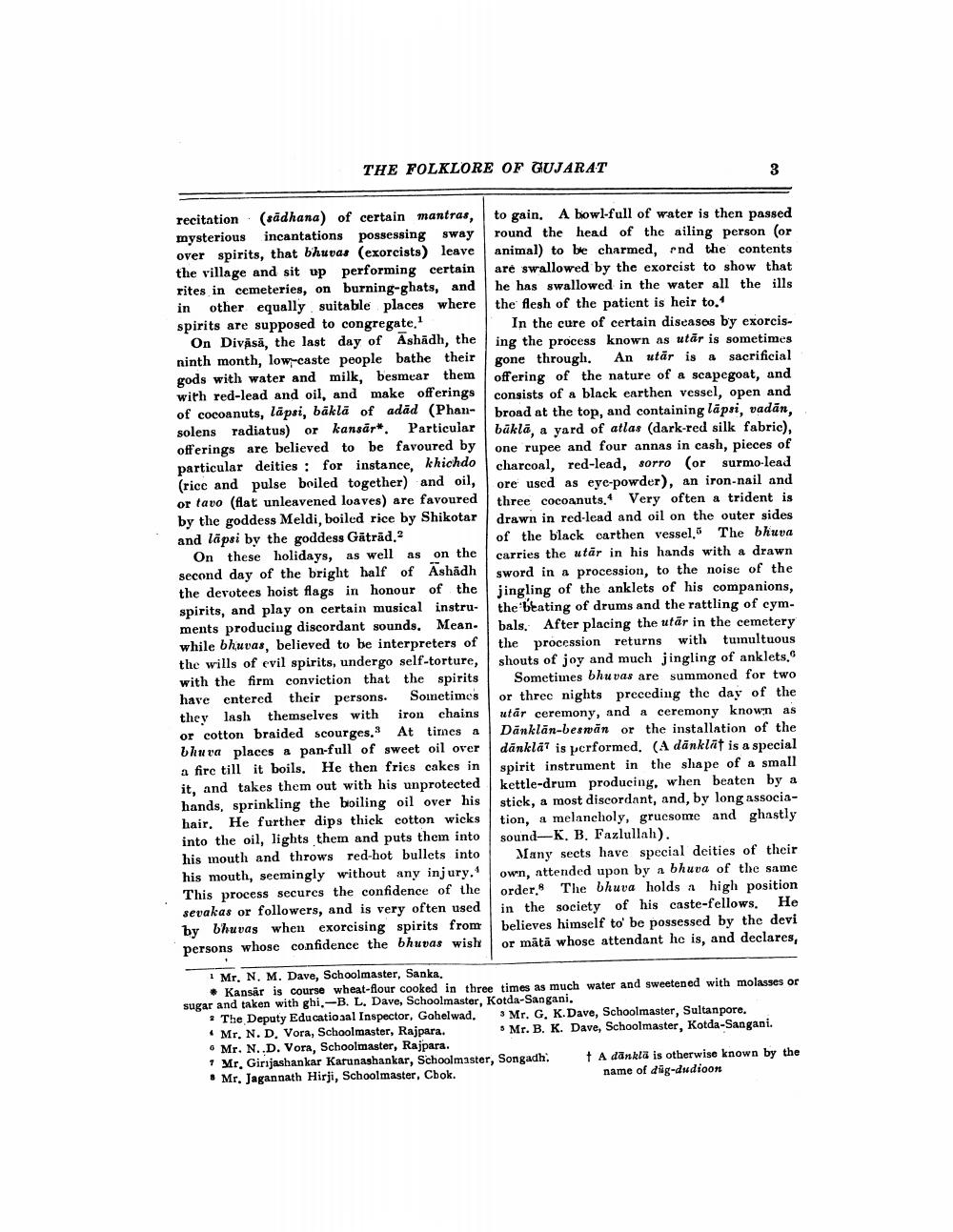________________
THE FOLKLORE OF GUJARAT
recitation (sādhana) of certain mantras, mysterious incantations possessing sway over spirits, that bhuvas (exorcists) leave the village and sit up performing certain rites in cemeteries, on burning-ghats, and in other equally suitable places where spirits are supposed to congregate."
On Diväsa, the last day of Ashadh, the ninth month, low-caste people bathe their gods with water and milk, besmear them with red-lead and oil, and make offerings of cocoanuts, lapsi, baklā of adăd (Phansolens radiatus) or kansär. Particular offerings are believed to be favoured by particular deities : for instance, khichdo (rice and pulse boiled together) and oil, or tavo (flat unleavened loaves) are favoured by the goddess Meldi, boiled rice by Shikotar and lapsi by the goddess Gäträd.2
On these holidays, as well as on the second day of the bright half of Ashadh the devotees hoist flags in honour of the spirits, and play on certain musical instruments producing discordant sounds. Mean. while bhuvas, believed to be interpreters of the wills of evil spirits, undergo self-torture, with the firm conviction that the spirits have entered their persons. Sometimes they lash themselves with iron chains or cotton braided scourges. At times a uhu va places a pan-full of sweet oil over a fire till it boils. He then fries cakes in it, and takes them out with his unprotected hands, sprinkling the boiling oil over his hair. He further dips thick cotton wicks into the oil, lights them and puts them into his mouth and throws red-hot bullets into his mouth, seemingly without any injury." This process secures the confidence of the sevakas or followers, and is very often used by bhuvas when exorcising spirits from persons whose confidence the bhuvas wish
to gain. A bowl-full of water is then passed round the head of the ailing person (or animal) to be charmed, and the contents are swallowed by the exorcist to show that he has swallowed in the water all the ills the flesh of the patient is heir to.
In the cure of certain diseases by exorcis. ing the process known as utar is sometimes gone through. An utār is sacrificial offering of the nature of a scapegoat, and consists of a black earthen vessel, open and broad at the top, and containing lāpsi, vadān, bāklā, a yard of atlas (dark-red silk fabric), one rupee and four annas in cash, pieces of charcoal, red-lead, sorro (or surmo-lead ore used as eye-powder), an iron-nail and three cocoanuts. Very often a trident is drawn in red-lead and oil on the outer sides of the black carthen vessel. The bhuva carries the utar in his hands with a drawn sword in a procession, to the noise of the jingling of the anklets of his companions, the beating of drums and the rattling of cym. bals. After placing the utär in the cemetery the procession returns with tumultuous shouts of joy and much jingling of anklets.
Sometimes bhuvas are summoned for two or three nights preceding the day of the utár ceremony, and a ceremony known as Dānklan-beswān or the installation of the dānklai is performed. (A dānklāt is a special spirit instrument in the shape of a small kettle-drum producing, when beaten by a stick, a most discordant, and, by long association, a melancholy, gruesome and ghastly sound-K, B. Fazlullah).
Many sects have special deities of their own, attended upon by a bhuva of the same order. The bhuva holds a high position in the society of his caste-fellows. He believes himself to be possessed by the devi or mata whose attendant he is, and declares,
Mr. N. M. Dave, Schoolmaster, Sanka.
• Kansår is course wheat flour cooked in three times as much water and sweetened with molasses or sugar and taken with ghi.-B. L, Dave, Schoolmaster, Kotda-Sangani.
• The Deputy Educatioaal Inspector, Gohelwad. Mr. G, K. Dave, Schoolmaster, Sultanpore. • Mr. N. D. Vora, Schoolmaster, Rajpara.
Mr. B. K. Dave, Schoolmaster, Kotda-Sangani. • Mr. N..D. Vora, Schoolmaster, Rajpara. " Mr. Girjashankar Karunashankar, Schoolmaster, Songadh. A dankla is otherwise known by the • Mr. Jagannath Hirji, Schoolmaster, Cbok.
name of dag-dudioon




